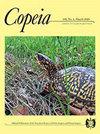A New Species of Chromis (Teleostei: Pomacentridae) from Mesophotic Coral Ecosystems of Rapa Nui (Easter Island) and Salas y Gómez, Chile
IF 2.6
Q2 Agricultural and Biological Sciences
引用次数: 7
Abstract
A new species of Chromis (Teleostei: Pomacentridae) is described from three specimens collected at 90 m depth in a mesophotic coral ecosystem at Rapa Nui, Chile. Chromis mamatapara, new species, can be distinguished from its congeners by the following combination of characters: dorsal-fin rays XIV,13–14; pectoral-fin rays 18–19, third from top of fin longest; tubed lateral-line scales 18; total gill rakers on first arch 30–32; vertebrae 11+15; and by coloration of living specimens, especially the presence of a single, pronounced, white spot, roughly the same diameter as the orbit, located where the posterior base of the dorsal fin intersects the caudal peduncle. The most similar DNA barcode (mitochondrial COI gene), among those available, is Chromis tingting from Japan (3.5% uncorrected divergence); however, C. mamatapara, new species, also superficially resembles other species for which sequences are unavailable for comparisons, including C. okamurai from Japan and C. struhsakeri from Hawaii. Due to the high geographic isolation and consequently high endemism in the Rapa Nui region, we believe that C. mamatapara, new species, is endemic to mesophotic ecosystems of Rapa Nui, Isla Salas y Gómez, and nearby seamounts, a discovery that contributes to the high endemism of the region and thus the need for conservation efforts.智利Rapa Nui(复活节岛)和Salas y Gómez中厚珊瑚生态系统的一新种(Teleostei: Pomacentridae)
在智利Rapa Nui的一个中孔珊瑚生态系统中,从90 m深度采集的三个标本中描述了一种新的Chromis (Teleostei: Pomacentridae)。新种mamatapara可通过以下特征组合与同属物种区分:背鳍射线XIV, 13-14;胸鳍射线18-19,从鳍的顶部第三最长;管状横向刻度18;上弓鳃耙总数30-32;椎骨11 + 15;通过活体标本的颜色,特别是存在一个单一的、明显的白点,它的直径与眼眶大致相同,位于背鳍后基部与尾柄相交的地方。在现有的DNA条形码(线粒体COI基因)中,最相似的是来自日本的Chromis tingting(未校正差异为3.5%);然而,新物种C. mamatapara在表面上也与其他无法比较序列的物种相似,包括来自日本的C. okamurai和来自夏威夷的C. struhsakeri。由于Rapa Nui地区高度地理隔离,因此具有高度地方性,我们认为C. mamatapara是Rapa Nui, Isla Salas y Gómez和附近海山的中游生态系统特有的新物种,这一发现有助于该地区的高地方性,因此需要采取保护措施。
本文章由计算机程序翻译,如有差异,请以英文原文为准。
求助全文
约1分钟内获得全文
求助全文
来源期刊

Copeia
生物-动物学
CiteScore
2.10
自引率
0.00%
发文量
0
审稿时长
6-12 weeks
期刊介绍:
Founded in 1913, Copeia is a highly respected international journal dedicated to the publication of high quality, original research papers on the behavior, conservation, ecology, genetics, morphology, evolution, physiology, systematics and taxonomy of extant and extinct fishes, amphibians, and reptiles. Copeia is published electronically and is available through BioOne. Articles are published online first, and print issues appear four times per year. In addition to research articles, Copeia publishes invited review papers, book reviews, and compiles virtual issues on topics of interest drawn from papers previously published in the journal.
 求助内容:
求助内容: 应助结果提醒方式:
应助结果提醒方式:


